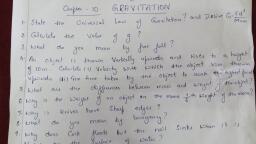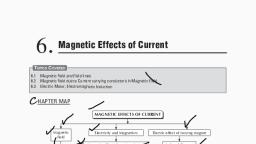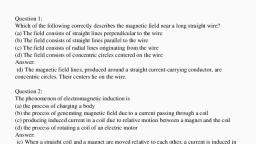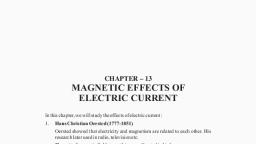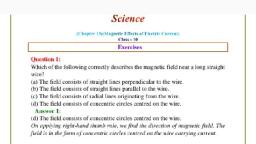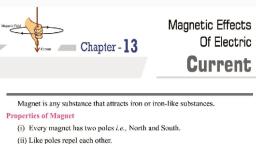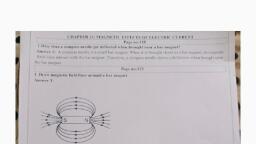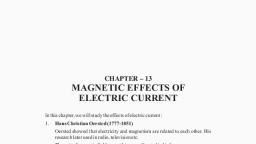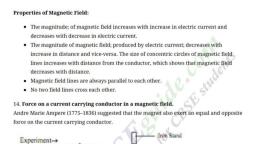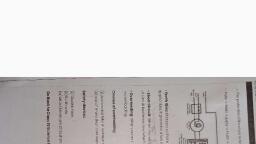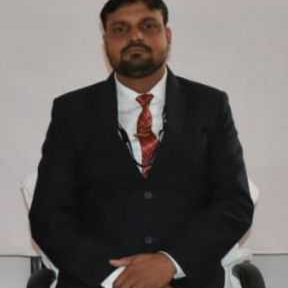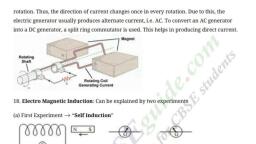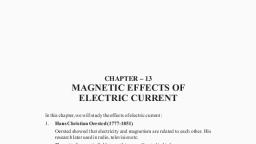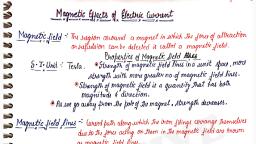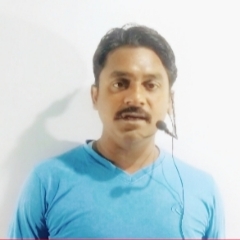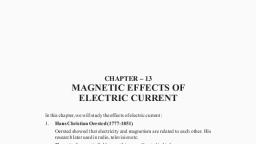Page 1 :
PDF download, , JAB SAARA INDIA, VEDANTU PE ONLINE PADHEGA, , Scholarship Admission Test, , , WIN an assured Scholarship upto 100%, , , , Take the Online Test from the comfort of your home, , , , It’s Absolutely FREE, , , , For, , Class 6-12, , Register NOW, Limited Seats!, , CBSE | ICSE | JEE | NEET, , W W W.V E D A N T U . C O M
Page 3 :
Intext Exercise 1, Question 1:, Why does a compass needle get deflected when brought near a bar magnet?, Solution 1:, A compass needle is a small bar magnet. When it is brought closer to a bar magnet, its, magnetic field lines interact with the bar magnet. Therefore, a compass needle, shows a deflection when brought near the bar magnet., Intext Exercise 2, Question 1:, Draw magnetic field lines around a bar magnet., Solution 1:, Magnetic field lines of a bar magnet emerge from the north pole and terminate at the, south pole. And the field lines emerge from the south pole inside the magnet and terminate, at the north pole, as shown in the below figure., , Question 2:, List the properties of magnetic lines of force., Solution 2:, The properties of magnetic lines of force are as follows., (a) Magnetic field lines arise from the north pole., (b) They terminate at the south pole., (c) The direction of field lines inside the magnet is from the south pole to the north pole., (d) Magnetic lines do not intersect with each other., Question 3:, Why don’t two magnetic lines of force intersect each other?, Solution 3:, When two field lines of a magnet intersect, the compass, needle points in two different directions at the point of intersection. This is not possible., Therefore, two field lines do not intersect each other., Intext Exercise3, Question 1:, Consider a circular loop of wire lying in the plane of the table. Let the current pass, through the loop clockwise. Apply the right-hand rule to find out the direction of the
Page 4 :
magnetic field inside and outside the loop., Solution 1::, Solution, Inside the loop = Pierce inside the table, Outside the loop = Appear to emerge out from the table, For downward direction of current flowing in the circular loop, the direction of magnetic, field lines will be as if they are emerging from the table outside the loop and merging in, the table inside the loop. Similarly, for the upward direction of the current flowing through the, circular, loop, the direction of magnetic field lines will be as if they are emerging from the table, outside the loop and merging in the table inside the loop, as shown in the given figure., , Q2. The magnetic field in a given region is uniform. Draw a diagram to represent it., Solution 2: Uniform magnetic field is represented by the parallel straight lines., , Question 3:, Choose the correct option., The magnetic field inside a long straight solenoid-carrying current, (a) is zero, (b) decreases as we move towards its end, (c) increases as we move towards its end, (d) is the same at all points
Page 5 :
Solution 3:, (d)The magnetic field inside a long, straight, current-carrying solenoid is uniform. Inside the, solenoid it is the same at all points., , Intext Exercise 4, Question 1:, Which of the following property of a proton can change while it moves freely in a, magnetic field? (There may be more than one correct answer.), (a) mass, (b) speed, (c) velocity, (d) momentum, Solution 1:, (c) and (d), When a proton enters a magnetic field area, it experiences a magnetic force. As a, result of the force, the path of the proton becomes circular. Therefore, its velocity and, momentum change., Question 2:, In Activity 13.7 (page: 230), how do we think the displacement of rod AB will be affected, if (i) current in rod AB is increased: (ii) a stronger horse-shoe magnet is used: and (iii), length of the rod AB is increased?, Solution 2:, In a magnetic field, a current-carrying conductor experiences a force. The magnitude of the, force increases with the amount of current, the magnetic field strength and the length of the, conductor. Hence, the magnetic force exerted on rod AB and its, deflection will increase if, (i) current in rod AB is increased, (ii) a stronger horse-shoe magnet is used, (iii) length of rod AB is increased, Question 3:, A positively-charged particle (alpha-particle) projected towards west is deflected towards, north by a magnetic field. The direction of magnetic field is, (a) towards south (b) towards east, (c) downward (d) upward, Solution 3:, (d) Using the Fleming’s left hand rule, the direction of the magnetic field can be determined, .According to this rule, stretch the thumb, forefinger and middle finger of your left hand such that, they are mutually perpendicular. If the first finger points in the direction of magnetic field and the, second finger in the direction of current, then the thumb will point in the direction of motion or, the force acting on the conductor Since, the direction of positively, charged alpha particle is towards west, the direction of current will be the same i.e.,
Page 6 :
towards west. Again, the direction of magnetic force is towards north. Therefore according, to Fleming’s left hand rule, the direction of magnetic field will be upwards., , Class X Chapter 13 – Magnetic Effects of Electric Current Science, Intext Exercise 5, Question 1:, State Fleming’s left-hand rule., Solution 1:, Fleming’s left hand rule states stretch the thumb, forefinger and middle finger of your left hand, such that they are mutually perpendicular If the first finger points in the direction of magnetic, field and the second finger in the direction of current, then the thumb will point in the direction of, motion or the force acting on the conductor, , Question 2:, What is the principle of an electric motor?, Solution 2:, An electric motor’s working principle is based on the magnetic effect of current. A currentcarrying loop experiences a force and rotates when placed in a magnetic field.The direction of, rotation of the loop is provided by Fleming's left-hand rule., Question 3:, What is the role of the split ring in an electric motor?, Solution 3:, It keeps the motor rotating in the same direction. The split ring in the electric motor acts as a, commutator. The commutator reverses the, direction of current flowing through the coil after each half rotation of the coil. Due to, this reversal of the current, the coil continues to rotate in the same direction., Intext Exercise 6, Question 1:, Explain different ways to induce a current in a coil., Solution 1: The different ways to induce a current in a coil are as follows:, (a) An electric current is induced in the coil, if a coil is moved rapidly between the two poles of a, horse-shoe magnet., (b) And if a magnet is moved relative to a coil,, Intext Exericse 7, Question 1:, State the principle of an electric generator., Solution 1:, An electric generator works on the principle of electromagnetic induction. It generates, electricity by rotating a coil in a magnetic field.
Page 7 :
Question 2:, Name some sources of direct current., Solution 2:, Some sources of direct current are cell, DC generator, etc., Question 3:, Which sources produce alternating current?, Solution 3:, AC generators, power plants, etc.produces alternating current., Question 4:, Choose the correct option., A rectangular coil of copper wire is rotated in a magnetic field. The direction of the, induced current changes once in each, (a) two revolutions, (b) one revolution, (c) half revolution, (d) one-fourth revolution, Solution 4:, (c) When a rectangular coil of copper is rotated in a magnetic field, the direction of the, induced current in the coil changes once in each half revolution., Intext Exericse 8, Question 1:, Name two safety measures commonly used in electric circuits and appliances., Solution 1:, Two safety measures commonly used in electric circuits and appliances are as follows:, (i)An electric fuse must be connected to each circuit. This prevents the flow of, excessive current through the circuit. When the current passing through the wire, exceeds the maximum limit of the fuse element, the fuse melts to stop the flow of, current through that circuit, thus protecting the appliances connected to the circuit., (ii) In order to prevent shocks, earthing is an important safety measure., . Any leakage of current in an electric appliance is transferred to the ground and people using, the appliance do not get the shock., Question 2:, An electric oven of 2 kW is operated in a domestic electric circuit (220 V) that has a, current rating of 5 A. What result do you expect? Explain., Solution 2:, Current drawn by the electric oven can be obtained by the expression,, , P =V I, Where,, Current = I
Page 8 :
Given: Power of the oven, P = 2 kW = 2000 W, And Voltage supplied, V = 220 V, I = 2000/220 = 9.09 A, So, the current drawn by the electric oven is 9.09 A, which exceeds the safety limit of, the circuit. Fuse element of the electric fuse will melt and break the circuit., Question 3:, What precautions should be taken to avoid the overloading of domestic electric circuits?, Solution 3:, Following precautions should be taken to avoid the overloading of domestic circuits:(a) Too, many appliances should not be connected to a single socket., (b) Too many appliances should not be used simultaneously., (c) Fuse should be connected in the circuit., (d) Faulty appliances should not be connected in the circuit., , NCERT EXERCISE, Question 1:, Which of the following correctly describes the magnetic field near a long straight wire?, (a) The field consists of straight lines perpendicular to the wire, (b) The field consists of straight lines parallel to the wire, (c) The field consists of radial lines originating from the wire, (d) The field consists of concentric circles centred on the wire, Solution 1:, (d) The magnetic field lines, produced around a straight current-carrying conductor, are, concentric circles. Their centres lie on the wire., Question 2:, The phenomenon of electromagnetic induction is, (a) the process of charging a body, (b) the process of generating magnetic field due to a current passing through a coil, (c) producing induced current in a coil due to relative motion between the magnet and the, coil, (d) the process of rotating a coil of an electric motor, Solution 2:, (c) When a straight coil and a magnet are moved relative to each other, a current is, induced in the coil. This phenomenon is known as electromagnetic induction., Question 3:, The device used for producing electric current is called a, (a) generator, (b) galvanometer
Page 9 :
(c) ammeter, (d) motor, Solution 3:, (a) An electric current is produced by an electric generator. It converts mechanical energy into, electricity., Question 4:, The essential difference between an AC generator and a DC generator is that, (a) AC generator has an electromagnet while a DC generator has permanent magnet., (b) DC generator will generate a higher voltage., (c) AC generator will generate a higher voltage., (d) AC generator has slip rings while the DC generator has a commutator., Solution 4:, (d) An AC generator has two rings called slip rings whereas a DC generator has two half rings, called commutator. This is the main difference between both the types of generators., Question 5:, At the time of short circuit, the current in the circuit, (a) reduces substantially, (b) does not change, (c) increases heavily, (d) vary continuously, Solution 5:, (c) When two naked wires of an electric circuit touch each other, the amount of current, flowing in the circuit increases abruptly. This causes short-circuit., Question 6:, State whether the following statements are true or false., (a) An electric motor converts mechanical energy into electrical energy., (b) An electric generator works on the principle of electromagnetic induction., (c) The field at the centre of a long circular coil carrying current will be parallel straight, lines., (d) A wire with a green insulation is usually the live wire of an electric supply., Solution 6:, (a) False, An electric motor converts electrical energy into mechanical energy., (b) True, A generator is an electronic device that generates electricity by rotating a coil in a magnetic, field. It works on the principle of electromagnetic induction., (c) True, A long circular coil is a long solenoid. The magnetic field lines inside the solenoid are, parallel lines.
Page 10 :
(d) False, Live wire has red insulation cover, whereas earth wire has green insulation colour in the, domestic circuits., Question 7:, List three sources of magnetic fields., Solution 7:, Three sources of magnetic fields are:, (a) Current-carrying conductors, (b) Permanent magnets, (c) Electromagnets, Question 8:, How does a solenoid behave like a magnet? Can you determine the north and south, poles of a current-carrying solenoid with the help of a bar magnet? Explain., Solution 8:, A solenoid is a long coil of insulated copper wire circular loops. When a current flows through it,, magnetic field lines are, produced around the solenoid. . The magnetic, field produced by it is similar to a bar magnet., , When the north pole of a bar magnet is brought close to the end, connected to the negative terminal of the battery, the solenoid repels the bar magnet., Since like poles repel they are like poles that is the end connected to the -ve ined is the north, pole. Therefore, the positive end of the solenoid is the south pole., , Question 9:, When is the force experienced by a current-carrying conductor placed in a magnetic field, largest?, Solution 9:, The force is maximum when the, direction of the current is perpendicular to the direction of the magnetic field., Question 10:
Page 11 :
Imagine that you are sitting in a chamber with your back to one wall. An electron beam,, moving horizontally from back wall towards the front wall, is deflected by a strong, magnetic field to your right side. What is the direction of magnetic field?, Solution 10:, The direction of magnetic field is given by Fleming’s left hand rule. Magnetic field inside, the chamber will be perpendicular to the direction of current (opposite to the direction of, electron) and direction of deflection/force i.e., either upward or downward. The direction, of current is from the front wall to the back wall because negatively charged electrons, are moving from the back wall to the front wall. The direction of magnetic force is rightward., Hence, using Fleming’s left hand rule, it can be concluded that the direction of magnetic, field inside the chamber is downward., Question 11:, Draw a labelled diagram of an electric motor. Explain its principle and working. What is, the function of a split ring in an electric motor?, Solution 11:, An electric motor converts electrical energy into mechanical energy., It works on the principle of the magnetic effect of current. A current-carrying coil rotates, in a magnetic field. The following figure shows a simple electric motor., A current is allowed to flow through the coil ABCD by closing the switch. Current in the length, AB flows from A to B and the magnetic field acts from left to right,, normal to length AB. Therefore, according to Fleming’s left hand rule, a downward force, acts on the length ABand at the same time, an upward force acts on the length CD. As a result,, the coil rotates, anti-clockwise., After half a rotation, the position of AB and CD interchange. The half-ring P comes in, contact with brush X and half-ring Q comes in contact with brush Y. Hence, the direction, of current in the coil ABCD gets reversed., , The current flows through the coil in the direction DCBA. The reversal of current through
Page 12 :
the coil ABCD repeats after each half rotation. As a result, the coil rotates unidirectional., The split rings help to reverse the direction of current in the circuit. These are called the, commutator., Question 12:, Name some devices in which electric motors are used?, Solution 12:, Water pumps, electric fans, electric mixers and washing machines are some devices in which, electric motors are used., Question 13:, A coil of insulated copper wire is connected to a galvanometer. What will happen if a bar, magnet is (i) pushed into the coil, (ii) withdrawn from inside the coil, (iii) held stationary, inside the coil?, Solution 13:, If a bar magnet is moved relative to a solenoid, a current is induced in it. This is the, principle of electromagnetic induction., (i) When a bar magnet is pushed into a coil of insulated copper wire, a current is induced, momentarily in the coil. As a consequence , the galvanometer’s needle momentarily deflects in, a particular direction., (ii) When the bar magnet is withdrawn from inside the coil of insulated copper wire,, a current is again induced momentarily in the coil in the opposite direction. As a result,, the galvanometer’s needle momentarily deflects in the opposite direction., (iii) When a bar magnet is held stationary inside the coil, no current will be induced in, the coil. Therefore, galvanometer will not show any deflection., Question 14:, Two circular coils A and B are placed close to each other. If the current in the coil A is, changed, will some current be induced in the coil B? Give reason., Solution 14:, Two circular coils A and B are placed close to each other. When the current in coil A is, changed, the magnetic field associated with it also changes. As a result, the magnetic, field around coil B also changes. This change in magnetic field lines around coil B, induces an electric current in it. This is called electromagnetic induction., , Question 15:, State the rule to determine the direction of a (i) magnetic field produced around a, straight conductor-carrying current, (ii) force experienced by a current-carrying straight, conductor placed in a magnetic field which is perpendicular to it, and (iii) current induced, in a coil due to its rotation in a magnetic field., Solution 15:, (i) Maxwell’s right hand thumb rule, (ii) Fleming’s left hand rule, (iii) Fleming’s right hand rule
Page 13 :
Question 16:, Explain the underlying principle and working of an electric generator by drawing a, labelled diagram. What is the function of brushes?, Solution 16: An electric generator converts mechanical energy into electrical energy. The, following figure shows an electric generator. It includes a rotating rectangular coil ABCD placed, between the two poles of a permanent magnet. The ends of this coil are connected to the two, rings R1 and R2 whose inner side are made insulated. The two conducting stationary brushes, B1 and B2 are kept pressed separately on the rings R1 and R2. These rings are internally, attached to an axle.The axle may be mechanically rotated from outside to the coil inside the, magnetic field. Outer ends of these brushes are connected to the galvanometer to show the flow, of current in the external circuit. When the axle connected to the two rings is rotated in such a, way that the arm AB moves up in the magnetic field produced by the permanent magnet., Suppose the coil ABCD is rotated clockwise. By applying Fleming’s right-hand rule, the induced, currents are generated in these arms along the directions AB and CD. Hence, an induced, current flows in the direction ABCD. If there are large numbers of turns in the coil, the current, produced in each turn adds up to give a large current through the coil which means the current, flows from B2 to B1., After the half rotation, arm CD moves up and AB moves down. Due to this, the directions of the, induced currents in both the arms change, which increases the net induced current in the, direction DCBA. Now, the current in the external circuit flows from B1 to B2. Therefore, after, each rotation the polarity of the current in the respective arm changes.Such a current that, changes direction after equal intervals of time is called an alternating current. So, this device is, called an AC generator., , In order to get a direct current, a split-ring type communator should be used. With this, arrangement, one brush is at all times in contact with the arm moves up, while the other moves, down. Therefore, a unidirectional current is generated. Hence, the generator is called a DC, generator.
Page 14 :
Question 17:, When does an electric short circuit occur?, Answer:, An electric short circuit occurs:, 1. When the resistance of an electric circuit becomes very low, and the current flowing, through the circuit becomes very high. This is caused by connecting too many devices, to a single socket or connecting high power rating appliances to the light circuits., 2. When the insulation of live and neutral wires undergoes wear and tear and then touches, each other, the current flowing in the circuit increases abruptly., Question 18:, What is the function of an earth wire? Why is it necessary to earth metallic appliances?, Solution 18:, Using an earth wire, the metallic body of electric appliances is connected to the earth so that, any electric current leakage is transferred to the ground. This prevents any electric shock to the, user. Therefore, earthing of electrical appliances is necessary.
Page 15 :
screen, , Access of Full, Syllabus Course, , Crash Course to Revise, Entire Syllabus, , Test Series and, Assignment, , Chapter Wise Course to, help you master One chapter, , Notes & Recordings, of every class, , Unlimited In-class, Doubt Solving, , Use VPROP & Get Extra 20% OFF, , Subscribe Now, https://vdnt.in/VPROPDF, , GRADES 6-12 | CBSE | ICSE | JEE | NEET
Page 16 :
Download, , Vedantu Learning APP, Free LIVE, MasterClasses, Unlimited Access, to Study Materials, Specially Designed, Tests, , Best of 2019 Winner, , USER’S CHOICE, APP AWARD 2019, Category, , Everyday Essentials, W W W.V E D A N T U . C O M, , DOWNLOAD, THE APP
Page 17 :
, , Thank You, , for downloading the PDF, , Samajh Aayega toh, Maza Aayega!!, , FREE MASTER CLASS SERIES, , , For Grades 6-12th targeting JEE, NEET, CBSE, ICSE & many more, , , , Free 60 Minutes LIVE Interactive classes everyday, , , , Learn from India’s Best Master Teachers, , W W W.V E D A N T U . C O M, , Register for FREE, Limited Seats!








